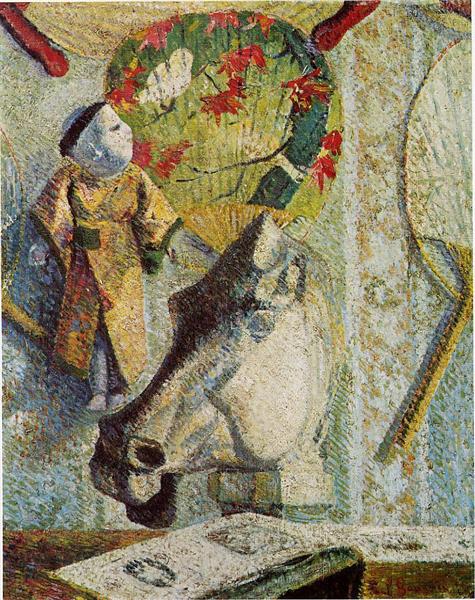Description
Paul Gauguin's Still Life with a Horse's Head, created in 1886, falls within a crucial period of the French painter's artistic development, who is recognized for his contribution to symbolism and for being a precursor to post-impressionism. This painting, in particular, stands out not only for its visual content, but also for the emotional complexity it evokes through a carefully orchestrated composition.
The work features a horse’s head in the foreground, an element evoking both life and death, a contrast that underlies the broader meaning of still life. The horse, depicted with an almost serene expression, appears to be in a state of repose, inviting the viewer to contemplate not only its physical representation, but also the inescapable cycle of existence. This thematic choice by Gauguin can be interpreted as a reflection on the fragility of life, a recurring theme in his work and one that is related to symbolism, which seeks to go beyond mere representation towards the expression of deep and emotional ideas.
The arrangement of objects in the painting reveals Gauguin’s mastery of composition. The horse’s head takes center stage, dominating the scene, while other elements such as fruit and a vase are arranged around it, creating a visual balance. The simplification of forms and the use of defined lines, characteristic of Gauguin’s style, contribute to the expression of a transitory reality. The rich, saturated colors range from dark to vibrant—red and yellow stand out in particular—adding a chromatic tension that elevates the work beyond a simple representation of inanimate objects.
It is interesting to note that while Still Life with a Horse's Head is a notable example of Gauguin's approach to still life, it also aligns with his experimentations in the use of color and form, which would culminate in his most iconic works in Tahiti. Gauguin employs a visual language here that foreshadows his future works, in which emotional and symbolic intent displaces mere naturalistic representation. His search for an art that would connect with the spiritual and the emotional is reflected in the way he harmonizes colors, guiding the viewer's eye through a sensory journey that arouses both admiration and introspection.
In the context of the art of the time, this work is also distinguished by its boldness and innovations in subject matter and technique. While other artists of his time tended to follow more traditional and careful approaches, Gauguin ventured to boldly explore the interplay between light, space and feelings. The painting cannot be considered a simple portrait of an object; it is a work that invites the viewer to a deep reflection on impermanence and the beauty of the moment, a theme that would resonate throughout art history.
Still Life with a Horse's Head is not only an exploration of Gauguin's art, but also a testament to his evolution as an artist at a time when he was seeking, through his work, a language that was authentic to his vision of the world. Through this work, Gauguin enters into a dialogue about existence, leaving a lasting mark on art history and challenging every viewer to look beyond the surface and explore the depths of the human experience.
KUADROS ©, a famous painting on your wall.
Hand-made oil painting reproductions, with the quality of professional artists and the distinctive seal of KUADROS ©.
Painting reproduction service with satisfaction guarantee. If you are not completely satisfied with the replica of your painting, we will refund 100% of your money.

